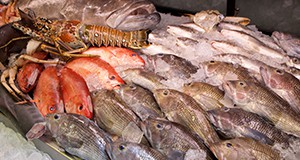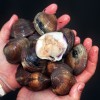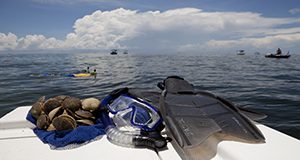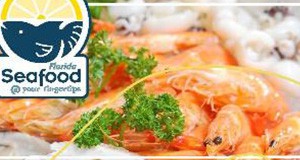This publication includes a full-color map identifying access routes to the boat ramps and marinas in Citrus County near Homosassa and Crystal River, plus the latest information on scallops and scalloping, the recommended equipment you will want to bring, and a few tasty recipes for preparing Florida’s best summertime catch. Written by Savanna Barry and published by the Florida Sea Grant College Program.
http://edis.ifas.ufl.edu/sg147
Tag: Seafood Industry
Identifying the Attitudes and Preferences of Parents and Children for Seafood: Summary of Focus Group Results

Seafood contains high-quality protein, vitamins, and minerals that have many health benefits, but the average family’s consumption of seafood in the United States remains below recommended levels. To begin to understand how to raise consumption levels, the study described in this three-page fact sheet focused on the influence parents’ seafood consumption habits may have on their children. Written by Anh Sam, Xiang Bi, and Lisa House and published by the Department of Food and Resource Economics.
http://edis.ifas.ufl.edu/fe992
Seafood Knowledge, Perceptions, and Use Patterns in Florida: Findings from a 2013 Survey of Florida Residents
Over the past few years, consumers have begun to pay more attention to the nutritional benefits, sustainability, and environment impact of consuming seafood. However, media coverage of these concerns may leave consumers confused and uncertain about how they should incorporate seafood into their diets. In 2013, a survey was conducted to better understand Florida seafood consumer preferences, perceptions, and concerns. This 4-page fact sheet explains the survey’s findings and how they might help Extension deliver effective seafood-based education to Florida residents. Written by Lisa Krimsky, Charles Adams, and Bryan Fluech, and published by the UF Department of Food and Resource Economics, May 2015. http://edis.ifas.ufl.edu/fe965
Tracking the Economic Benefits Generated by the Hard Clam Aquaculture Industry in Florida
 The hard clam industry is a true success story for commercial aquaculture in Florida. From a cottage industry borne of reductions in commercial wild clam harvests in the Indian River Lagoon during the late 1980s, hard clam aquaculture has now developed into an industry that is rivaled by no other aquaculture food product in Florida. Although successful by virtually any metric, the risks and uncertainty associated with commercial hard clam culture has led to the evaluation of programs that help mitigate risk, such as the former pilot Cultivated Clam Crop Insurance Program administered by USDA Risk Management Agency. All of this alludes to the economic importance of the hard clam culture industry which, through the cultivation process and sales of products, generates local income and taxes, creates jobs and businesses, and draws new money into the local economy, as cultured hard clams are sold to non-residents and buyers outside the region and state. This 6-page fact sheet provides an overview of a recent study by the University of Florida to provide an estimate of the impact of the hard clam industry to the Florida economy. Written by Charles Adams, Leslie Sturmer, and Alan Hodges, and published by the UF Department of Food and Resource Economics, October 2014. (UF/IFAS photo by Tom Wright)
The hard clam industry is a true success story for commercial aquaculture in Florida. From a cottage industry borne of reductions in commercial wild clam harvests in the Indian River Lagoon during the late 1980s, hard clam aquaculture has now developed into an industry that is rivaled by no other aquaculture food product in Florida. Although successful by virtually any metric, the risks and uncertainty associated with commercial hard clam culture has led to the evaluation of programs that help mitigate risk, such as the former pilot Cultivated Clam Crop Insurance Program administered by USDA Risk Management Agency. All of this alludes to the economic importance of the hard clam culture industry which, through the cultivation process and sales of products, generates local income and taxes, creates jobs and businesses, and draws new money into the local economy, as cultured hard clams are sold to non-residents and buyers outside the region and state. This 6-page fact sheet provides an overview of a recent study by the University of Florida to provide an estimate of the impact of the hard clam industry to the Florida economy. Written by Charles Adams, Leslie Sturmer, and Alan Hodges, and published by the UF Department of Food and Resource Economics, October 2014. (UF/IFAS photo by Tom Wright)
http://edis.ifas.ufl.edu/fe961
Florida MarketMaker and Florida Food Connect: Using E-commerce to Enhance Seafood Marketing in Florida
 While the state and many non-profit organizations provide information to the Florida seafood and aquaculture industry to help them market their catch, they offer few resources facilitating e-commerce. As a business tool, e-commerce can help expedite the buying and selling of seafood products among consumers, producers, and other businesses within the food industry value chain. E-commerce is a new promotional strategy producers can use to improve their marketing efficiency. For example, the affiliated websites Florida MarketMaker and Florida Food Connect are designed to enhance the online presence for the Florida seafood industry. Web portals such as these increase the visibility of seafood businesses by allowing dealers to create a searchable online profile attracting more customers seeking locally sourced seafood. This 6-page fact sheet was written by Charles M. Adams and William Barker, and published by the UF Department of Food and Resource Economics, May 2014.
While the state and many non-profit organizations provide information to the Florida seafood and aquaculture industry to help them market their catch, they offer few resources facilitating e-commerce. As a business tool, e-commerce can help expedite the buying and selling of seafood products among consumers, producers, and other businesses within the food industry value chain. E-commerce is a new promotional strategy producers can use to improve their marketing efficiency. For example, the affiliated websites Florida MarketMaker and Florida Food Connect are designed to enhance the online presence for the Florida seafood industry. Web portals such as these increase the visibility of seafood businesses by allowing dealers to create a searchable online profile attracting more customers seeking locally sourced seafood. This 6-page fact sheet was written by Charles M. Adams and William Barker, and published by the UF Department of Food and Resource Economics, May 2014.
http://edis.ifas.ufl.edu/fe944
Recreational Harvesting of the Florida Bay Scallop, Citrus County (SGEF187/SG102)
 Scalloping is a favorite summer pastime along the central west and northwest coasts of Florida. This publication offers a brief biology lesson on bay scallops along with everything you need to know about scalloping—legal requirements, equipment needed, how to collect and handle scallops, recipes, and information on scallop research and restoration. The brochure also includes a boat ramp and marina locator map for the Citrus County area. Written by Don Sweat and Fred Vose, and published by the UF Department of Sea Grant, June 2011.
Scalloping is a favorite summer pastime along the central west and northwest coasts of Florida. This publication offers a brief biology lesson on bay scallops along with everything you need to know about scalloping—legal requirements, equipment needed, how to collect and handle scallops, recipes, and information on scallop research and restoration. The brochure also includes a boat ramp and marina locator map for the Citrus County area. Written by Don Sweat and Fred Vose, and published by the UF Department of Sea Grant, June 2011.
http://edis.ifas.ufl.edu/sg102
FE835 Economic Impacts of Alternative Regulatory Scenarios on the Florida Fresh Half-Shell Oyster Industry: A Study of Potential Outcomes
FE835, a 3-page executive summary of a report by K.L. Morgan, T.J. Stevens, R.L. Degner, S.L. Larkin, and C.M Adams, summarizes the results of a study to examine the economic impacts of possible closures of the fresh half-shell oyster market for varying time periods with the intention of protecting consumers from Vibrio vulnificus infections. Published by the UF Department of Food and Resource Economics, June 2010.
http://edis.ifas.ufl.edu/fe835
FE822 Attitudes and Preferences of People Aged 55 and Above for Seafood: Summary of Telephone Survey Results
FE822, an 8-page illustrated fact sheet by Lisa House, Allen F. Wysocki, William A. Messina, Jr., and Kathryn Olson, presents a brief summary of information on consumer perceptions of seafood obtained from a 2008 survey to identify the attitudes and consumption behavior of consumers aged 55 and
older for fish, shellfish, and aquaculture products. Published by the UF Department of Food and Resource Economics, April 2010.
http://edis.ifas.ufl.edu/fe822
FE821 Seafood Perceptions among People Aged 55 and Above: Summary of Focus Groups Results
FE821, a 6-page fact sheet by Allen F. Wysocki, Lisa House, and William A. Messina, Jr., provides a brief summary of the focus group part of a study of perceptions of Florida residents aged 55 and over on seafood consumption. Published by the UF Department of Food and Resource Economics, November 2009.
http://edis.ifas.ufl.edu/FE821

